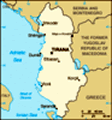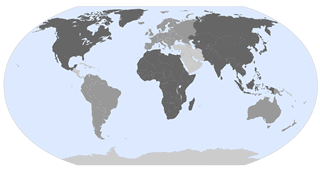Advertisement
Published: October 2nd 2022
We said in a previous blog, we think, that there are two things you get on every Explore trip - ruins and churches. At that time we forgot the third. That is... at least one "today will be a long drive" with a full body massage freely included.
Thursday was that day for this trip, consisting of 3 or 4 long drives. Remember also a couple of blogs ago the reference to Paul's "interesting" roads and Pip's "do we really need to do this"? Most of the first half of Thursday's long miles fell into this category.
Whilst the road was not rocky or gravelly the tarmac was at best nominal, with the bus' axis wheelbase surely being wider than what tarmac did actually exist. Even Paul admitted that Thursday's drive might have been "too interesting" even for him.
First stop, shortly after leaving our overnight stop at Korca was the Kamenica archaeology site and museum. This is a - partly - excavated tumulus, work on which has shown that its origins date back 7000 years.
It was excavated in "seasons" between 2000 and 2007, and revealed an extensive community from 13th to 6th century BC. 400
graves/440 skeletons, individual bodies, man/woman, women & young children /babies, many with artefacts eg pots, jewellery. But no discernable weapons have been found.
Recent work uncovered the skeleton of a pregnant women and her unborn child dating to 3000 BC.
No work has been done on the site for some time now, exampled by the dig site now having wild grass growing totally over it.
The, rough road, route took us through the Albanian southern highlands via the Barmash Pass at 1040m with sweeping views of the Nemercka Mountains forming the border with Greece. As we drove alongside the river, which is the border between Albania and Greece, all our phones received messages from our cell-phone provider "Welcome to Greece. You may....." continuing then according to how each of our phone contacts work. Later that day they had all reverted to "Welcome to Albania...."
Erseke, a small communist style town in its old buildings, provided a small coffee stop. Somehow we have still not solved the coffee issue as we both ended up with strong, black, even though we ordered lattes. Others nearby ordered cappuccino and got drinks twice the size of ours.
That said,
usually, during an English morning coffee stop, Pip will order hot chocolate. A couple of our group did so here. When it arrived it was basically half a cup of melted dark milk chocolate that had to be ladled out with a spoon.
Continuing on to our stop for that Thursday night, Permet, we had a photo stop at an imposing partisan statue. The "official" story from the time was that the brave partisans killed 60 attacking German soldiers, saving many children into the bargain.
But, in actuality, the partisans had no weapons. What really happened is that they killed 1 or 2 Germans, who then wiped out whole Albanian villages in revenge.
Our lunch stop was in the middle of a national park forest, at something of a tourist complex. In addition to the restaurant where the group ate there was reference to adventure activities, accommodation and there was even a blue lined swimming pool in the grounds.
There are supposed to be wolves and bears in the forest, but we saw none of them. Just lots of ducks waddling around, and lots of local trout in concrete holding tanks ready for lunch.
In
the afternoon, two visits:
Firstly a 6km round trip walk up to a remote village, at the base of which was yet another church, though this one was locked. Some lovely valley views on the way.
On the way up whoever was at the front of the group let out a scream that could have woken the dead. They had spotted a snake on the track, up to a metre by all accounts. Sadly we were some way back and it had gone by the time we reached the spot. Pip was mortified to have missed seeing it, and spent the rest of the walk looking in the undergrowth rather than admiring the view.
Then a drive to some "thermal springs". Let's be clear, we are not talking Icelandic Blue Lagoon hot springs here. This was essentially a "just a few degrees above ambient temperature" spring, at around 22°C. Apparently just a few years ago it used to be noticeably warmer but some seismic activity affected that.
One of the group braved the lack of changing facilities and made it in the pool for a swim.
Access was by a 18th C Ottoman stone arch
bridge, a very up and down structure.
Sometime during the day, given the hundreds of cats (and dogs) that we see everywhere we go, one of the group asked Alfred, our guide,
"Do Albanians like cats?", to which Alfred replied "We don't eat them!“
During these two days we have also seen so much fruit. Not just in road side shops and stalls but in gardens and fields & orchards.
Vines, dripping with ripe grapes, in practically every garden, and pomegranate in most gardens too, plus apples, kiwi, olive, quince, plums, walnuts, figs, citrus...
Friday, after breakfast the group walked up to the village of Leusa, to visit the 18th C church of St Mary, an Albanian "cultural momument". This had to be opened with an enormous key that Alfred had to fetch from nearby.
This was another highly decorated church, though with no custodian present to restrict photos being taken.
The torture frieze was particularly gruesome in this one.
The drive to Gjirokastra, our overnight stop for Saturday, took us through the White Mountains via the Kelcyra Gorge carved by the Vjose River on its way to the Adriatic Sea.
Stunning
scenery, the gorge is well known as a hunting ground for eagles. But sadly none spotted, certainly not by us.
Arriving in Gjirokastra, we checked in to our hotel and than had some free time for a personal wander and an ice cream, before a more formal guided walking tour.
The pretty town, probably the most "tourists visit for unspoilt layout and buildings" of the trip so far is UNESCO listed and so is pretty untouched in the centre - eat your heart out Liverpool. That doesn't stop all the shop holders from displaying all their identical rugs, hats, earrings etc on the front steps.
The castle above the town sits at 330 metres and has amazing views over the surrounding hilly countryside.
Extensive renovations have been made to the building since its construction in the 12th C. It now has 5 towers, a church, houses and a heavy weapons museum with exhibits from the Communist resistance against German occupation. Up top is a captured US Air Force fighter plane, from the Cold War of 1957, put there to commemorate the Communist regime's "struggle against the 'imperialist' western powers".
There are also a number of
British cannons up top, embossed with a rose & crown moniker and the British Army equipment mark of ->, apparently gifted from Great Britain by "the Queen" though we couldn't establish whether that meant Elizabeth or Victoria.
Down into the Old Town area to Skenduli House, one of the best preserved Ottoman houses in the town.
Dating to 1700, it was spread over 3 floors. Bottom level for goods and storage, but the animals were kept in a separate stable block. There was a built-in water tank that held thousands of gallons of clean water. Its tap was some centimetres above the base of the tank so that any gunge settled out.
On this level there was also a double ceilinged, internal "protective room" for use if invaded.
1st floor was living area with lovely panelled rooms, and an outlook which was spectacular even now, and would have impressed visitors in its time when it would have had few, if any, buildings to interfere. There was also a "flushing" loo, with piping which would take the waste away from the house to the river (rather than the Blackadder classic of out of the window into the
road below).
The house was one of the many that was forcibly taken from its owners/family - who in this example had owned it since it was built, never 'sold on' - and requisitioned during the communist regime. It was turned into a museum.
Eventually, after communism, the family got it back and decided to use it as a 'house' museum.
In the early evening we were taken to a village, Dhkosat, 30 mins away across the valley for a "family meal" (included in the holiday, unlike all other meals except breakfast).
What a wonderful treat that was. Cooked by the wife/mother of the family, and in good weather so we were seated outside. Vegetarian, served almost like a series of tapas dishes, 10 to a dozen or so nicely paced out one after the other. Tomato/feta bruschetta, goats' cheese, beetroot, mixed salad, aubergine ratatouille and a delicious tomato baked aubergine dish, stuffed peppers, two types of byrek (a filo pastry layered with cheese and or spinach /wild herbs)... finished with a syrupy sponge cake.... and then complimentary home made raki, the Albanian fire water/grapa which was surprisingly less rough than we expected.
We all
returned to town well repleat.
Seen lots of, part 2
Advertising stencilled onto road edge reinforcement
Visiting motorcyclists enjoying the twisting mountain roads
Teddy bears hung up on houses to ward off evil spirits
Advertisement
Tot: 0.439s; Tpl: 0.013s; cc: 7; qc: 62; dbt: 0.0987s; 1; m:domysql w:travelblog (10.17.0.13); sld: 1;
; mem: 1.2mb




















